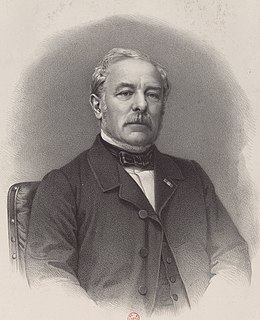
Louis Lartet was a French geologist and paleontologist. He discovered the original Cro-Magnon skeletons.

Étienne Jules Adolphe Desmier de Saint-Simon, Vicomte d'Archiac was a French geologist and paleontologist.

Alcide Charles Victor Marie Dessalines d'Orbigny was a French naturalist who made major contributions in many areas, including zoology, palaeontology, geology, archaeology and anthropology.

Paul Gervais full name François Louis Paul Gervais was a French palaeontologist and entomologist.

Nicolas Auguste Pomel was a French geologist, paleontologist and botanist. He worked as a mines engineer in Algeria and became a specialist in north African vertebrate fossils. He was Senator of Algeria for Oran from 1876 to 1882.

The Gallery of Paleontology and Comparative Anatomy is a part of the French National Museum of Natural History. It is situated in the Jardin des plantes in Paris near the Gare d'Austerlitz.

Crassispira is a genus of small predatory sea snails with narrow, high-spired shells, marine gastropod mollusks in the family Pseudomelatomidae.

Palaeocoma d'Orbigny, 1850, is an extinct genus of brittle stars that lived during the Middle Triassic to Early Jurassic Periods. Its fossils have been found in Europe.

Mahavisaurus is an extinct genus of rhytidosteid temnospondyl from the early Triassic period of Iraro, Madagascar. It is known from the holotype MNHN MAE 3037, a nearly complete skull, recovered from the Middle Sakamena Formation. This genus was named by J. P. Lehman in 1966, and the type species is Mahavisaurus dentatus.

Drillia is a genus of small sea snails, marine gastropod mollusks in the family Drilliidae.

Ophiopetra is a genus of prehistoric brittle stars. It lived in lagoons in Solnhofen Plattenkalk Formation. It has only one known species, Ophioptera lithographica.

Gaston de Saporta was a French aristocrat, palaeobotanist and non-fiction writer.

Gustave Honoré Cotteau was a French judge, naturalist and paleontologist.
Comophyllia is an extinct genus of prehistoric stony corals in the family Latomeandridae. Species are known from the Jurassic and Cretaceous. C. elegans, the type species, is from the Jurassic of France.

Cribrospongia is an extinct genus of prehistoric sponges in the family Cribrospongiidae. The species C. elegans is from the Jurassic period and has been found in Germany.
Victor-Auguste Gauthier was a French school teacher and amateur palaeontologist. He specialized in the study of fossilized sea urchins, contributing meticulous descriptions of many fossils found in southern France, Algeria, Tunisia and Persia.
The Bulletin de la Société Géologique de France, otherwise known as BSGF - Earth Sciences Bulletin is a peer-reviewed open access scientific journal covering Earth sciences. The journal publishes articles, short communications, reviews, comments and replies. It is published by EDP Sciences and the editor-in-chief is Laurent Jolivet. The journal was established in 1830. It is a publication of the Société géologique de France. Most of the older content, published before 1924 is available online at the Biodiversity Heritage Library.

Eocithara is an extinct genus of sea snails, marine gastropod mollusks, in the family Harpidae.
Antarcticoceras is a genus of crioconic ammonites in the family Shasticrioceratidae. It lived during the Early Cretaceous Period. Antarcticioceras fossils can be found in the Cretaceous rocks of Antarctica and South America.

Narindasaurus is a genus of turiasaurian sauropod dinosaur from the Middle Jurassic Isalo III Formation of Madagascar. The type species, N. thevenini was formally described by Royo-Torres et al. in 2020. The holotype, which consists of one specimen, is currently stored at the Muséum national d’Histoire naturelle and has been since 1906 or 1907.















